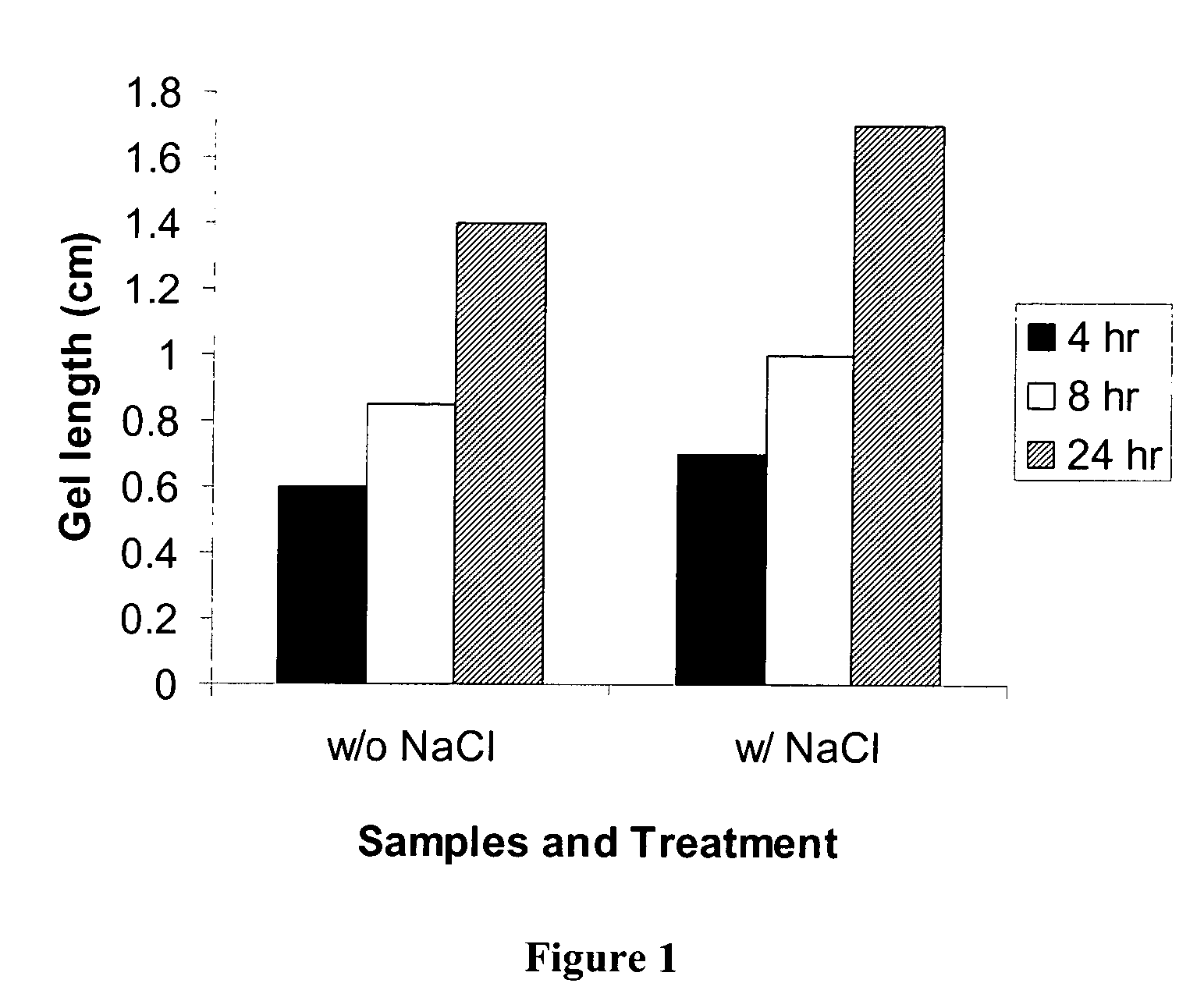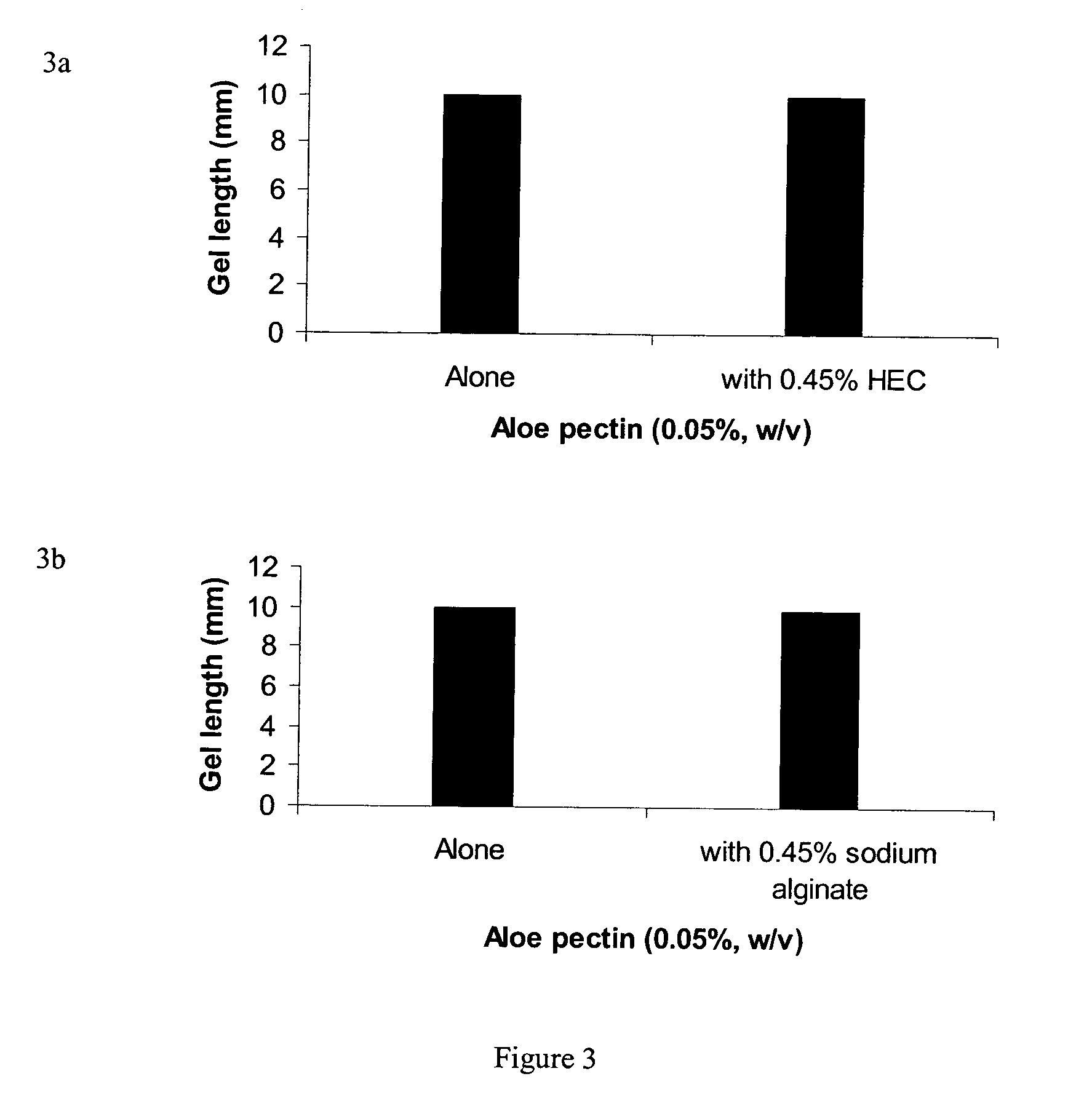Delivery of physiological agents with in-situ gels comprising anionic polysaccharides
- Summary
- Abstract
- Description
- Claims
- Application Information
AI Technical Summary
Benefits of technology
Problems solved by technology
Method used
Image
Examples
example 1
In-Situ Gelation of Aloe Pectins
Extraction of Aloe Pectin
[0166]Aloe pectin was extracted from cell wall fibers prepared from either pulp or rind of Aloe vera leaves. The general methods of extracting pectins have been reported. See, Voragen et al, In Food polysaccharides and their applications. pp 287-339. Marcel Dekker, Inc. New York, 1995. See also, U.S. Pat. No. 5,929,051, the entire content of which is hereby specifically incorporated by reference. The extraction of Aloe pectin was achieved with a chelating agent such as EDTA or under other conditions including hot water, hot diluted acid (HCl, pH 1.5-3), and cold diluted base (NaOH and Na2CO3; pH 10).
[0167] Following the initial extraction, the remaining fibers were removed by coarse and fine filtrations. The pectin was precipitated with ethanol. The pectin precipitates were further rinsed with ethanol solutions before being dried.
[0168]Aloe pectins obtained in this manner from either pulp or rind cell wall fibers were cha...
example 2
In-Situ Gelation Following Topical Application to a Wound Surface
[0176]Aloe pectin preparation (0.5%, w / v) in physiological saline was directly applied to fresh full-thickness excisional skin wounds on mice or rats. A 0.5% (w / v) CMC preparation in physiological saline and a commercial hydrogel wound dressing were used as a control. The wounds were made with a biopsy punch in accordance with animal use protocols. After 4 hrs, rats were sacrificed and wounds surgically removed. Wounds were fixed in formalin, sectioned, and stained with H&E. A layer of gel was clearly visually observable on the surface of wounds with the Aloe pectin preparation but not with CMC or the commercial hydrogel wound dressing.
example 3
Pectin In-Situ Gelation Mediated by Calcium Ions in Body Fluids, as Measured by A Gel Frontal Migration Assay
[0177] Body fluids such as blood, lacrimal fluid, lung fluid and nasal secretions contain calcium ions (8.5-10.3 mEq / dl in blood, for example). Since Aloe pectin forms calcium gel, the role of calcium in the in-situ gelation of Aloe pectin was examined using an in vitro gelling assay with animal serum that simulates in-situ gel formation. This in vitro assay is described as a gel frontal migration assay. Animal serum was placed at the bottom of a glass tube and the Aloe pectin solution was layered on top of the serum (the pectin solution may also be placed at the bottom of the tube dependent on the density of the test solution in relation to the pectin solution). Tissue culture grade normal calf serum was used. Two ml of serum was placed at the bottom of a glass tube (0.8×11 cm) and 1 ml pectin solution (0.5-0.75%, w / v) was placed on top of it.
[0178] Gel formation was immed...
PUM
| Property | Measurement | Unit |
|---|---|---|
| Fraction | aaaaa | aaaaa |
| Fraction | aaaaa | aaaaa |
| Fraction | aaaaa | aaaaa |
Abstract
Description
Claims
Application Information
 Login to View More
Login to View More - R&D
- Intellectual Property
- Life Sciences
- Materials
- Tech Scout
- Unparalleled Data Quality
- Higher Quality Content
- 60% Fewer Hallucinations
Browse by: Latest US Patents, China's latest patents, Technical Efficacy Thesaurus, Application Domain, Technology Topic, Popular Technical Reports.
© 2025 PatSnap. All rights reserved.Legal|Privacy policy|Modern Slavery Act Transparency Statement|Sitemap|About US| Contact US: help@patsnap.com



